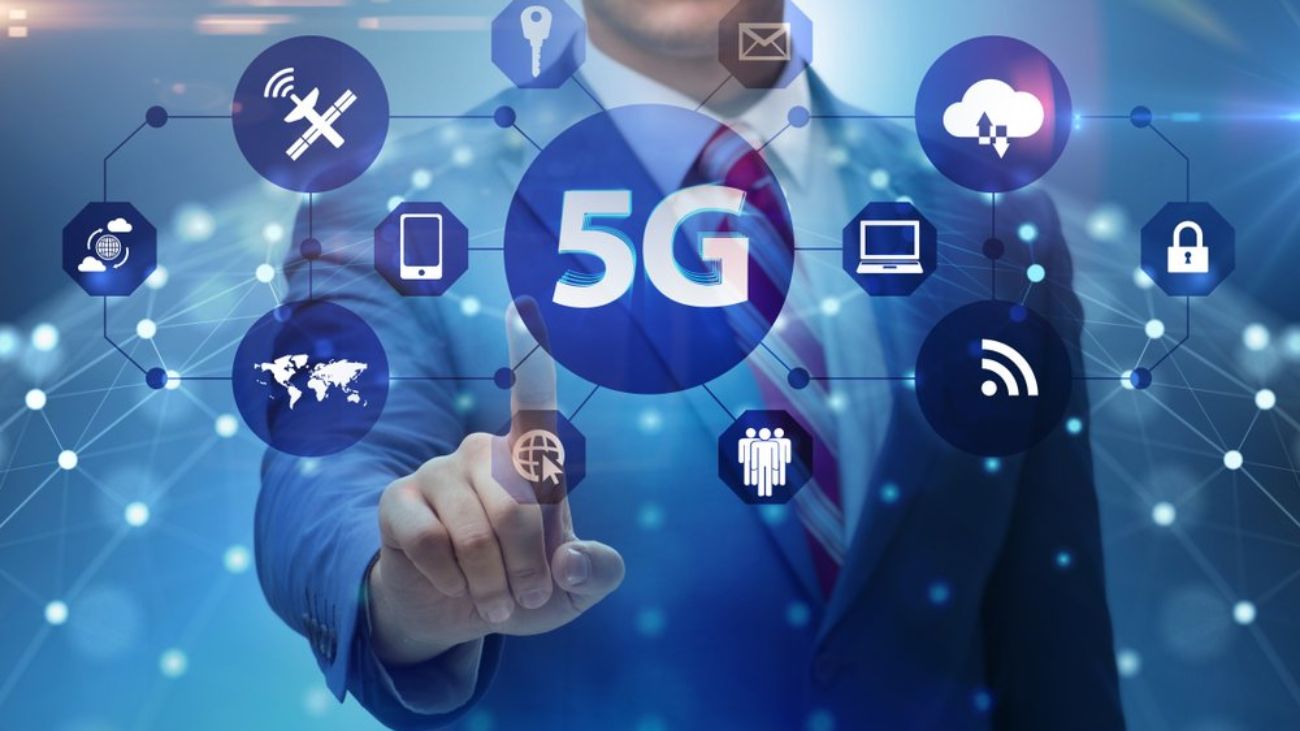Imagine a world where downloading a full-length movie to your phone takes mere seconds, autonomous vehicles communicate with each other seamlessly to prevent accidents, and smart cities autonomously manage traffic flows to eliminate congestion. This isn’t a scene from a sci-fi movie, but the very near future powered by 5G technology. The advent of 5G, the fifth generation of mobile networks, isn’t just an upgrade of wireless systems but a giant leap that’s poised to redefine the realm of digital communication. With its promise to drastically improve data speeds, reduce latency, and connect a myriad of devices, 5G stands as the cornerstone of a forthcoming technological revolution. As we stand on the brink of this new era, understanding the profound implications of 5G on the telecommunications sector is crucial not only for industry stakeholders but for every individual poised to partake in this digital renaissance. In this exploration, we delve into the heart of 5G’s impact on telecommunications, shedding light on how it’s not merely shaping the sector but unleashing a future brimming with unbounded potential.
What to Know about 5G
5G, which stands for the fifth generation of wireless communication technologies, is a leap forward in the realm of mobile connectivity. It’s not just a simple upgrade from the previous 4G; it’s a significant overhaul that promises to reshape how we interact with technology and the world around us. Here are several key points about 5G that you should know:
Speed and Bandwidth
5G offers vastly improved speeds and bandwidth compared to its predecessor, 4G. With peak data rates of up to 20 Gbps, it’s about 20 times faster than 4G. This remarkable speed opens the doors to real-time communication and the downloading or streaming of high-definition content with virtually no lag.
Lower Latency
One of the most touted benefits of 5G is its low latency, which is the time it takes for data to travel from one point to another. 5G aims to reduce latency to a mere 1 millisecond, which is imperceptible to humans. This feature is crucial for applications where even a slight delay can be problematic, such as in autonomous driving or remote surgeries.
Enhanced Capacity
5G networks have a higher capacity, meaning they can handle more simultaneous connections per square kilometer than previous generations. This is particularly beneficial in densely populated areas where networks tend to get congested, ensuring a smoother user experience.
Improved Connectivity
The enhanced connectivity of 5G extends to rural and remote areas, providing better coverage and internet speeds. This is a step towards bridging the digital divide that exists between urban and rural regions.
Network Slicing
5G introduces the concept of network slicing, which allows for the creation of virtually isolated networks with different characteristics. This is beneficial for tailoring connectivity solutions to specific use cases, ensuring optimal performance for various applications.
Massive IoT Enablement
The high capacity and low latency of 5G make it a perfect match for the Internet of Things (IoT). It’s set to enable massive IoT deployments, allowing for the interconnection of billions of devices and creating smarter, more efficient systems.
Potential Health Concerns
There have been concerns regarding the health impacts of 5G, mainly due to the higher frequency bands it uses. However, most research to date has found no significant risk associated with 5G radiation.
Infrastructure Challenges
The rollout of 5G necessitates the deployment of new infrastructure, including small cells and new antennas. This requires significant investments and may face opposition from communities concerned about the aesthetic or health impacts.
The 5G Revolution in Telecommunications
The introduction of 5G technology is nothing short of a revolution in the telecommunications sector. This fifth generation of wireless communication technologies is set to drastically change the way we communicate, interact, and do business. Here’s a closer look at the transformative impact of 5G in the telecommunications realm:
Enhanced Mobile Broadband (eMBB)
5G is bringing about a substantial upgrade in mobile broadband services by providing significantly higher data rates and improved performance. The enhanced mobile broadband capability of 5G facilitates the streaming of ultra-high-definition videos, virtual reality experiences, and other data-intensive applications without the glitches and lags commonly associated with previous generation networks.
Ultra-Reliable Low Latency Communications (URLLC)
One of the hallmark features of 5G is its ultra-reliable low latency communications. With a latency of just 1 millisecond, 5G ensures real-time communication which is crucial for various applications such as autonomous driving, industrial automation, and remote medical procedures. This low latency characteristic of 5G is a game changer for numerous sectors reliant on instantaneous data transmission.
Massive Machine Type Communication (mMTC)
5G is paving the way for massive machine type communication, enabling the interconnection of a large number of devices. This is particularly beneficial for Internet of Things (IoT) applications, where devices need to communicate with each other seamlessly. The mMTC feature of 5G facilitates large-scale connectivity and is instrumental in the development of smart cities, smart homes, and industrial IoT.
Network Flexibility
The flexibility of 5G networks is another revolutionary aspect. With technologies like network slicing, 5G can create virtually isolated networks with tailored connectivity solutions. This is crucial for meeting the diverse requirements of various applications, ensuring optimal performance and efficiency.
Improved Coverage and Connectivity
5G technology is set to expand coverage and enhance connectivity, even in remote and rural areas. This is a significant step toward bridging the digital divide and ensuring that more people have access to high-speed, reliable internet services.
Security Enhancements
With the advent of 5G, there’s a heightened focus on network security. The robust security features of 5G are designed to handle the increased connectivity and the associated security challenges, ensuring safer communication channels.
Economic and Societal Impact
The economic impact of the 5G revolution is profound. By enabling new business models and services, 5G is set to create job opportunities, drive innovation, and contribute significantly to economic growth. Moreover, the societal benefits include improved emergency services, healthcare delivery, and educational resources.
The 5G revolution is much more than just an upgrade in telecommunications technology. It’s a catalyst for innovation and transformation across various sectors of the economy. As 5G networks continue to roll out globally, the ripple effects of this technological advancement will be felt far and wide, marking a significant milestone in the digital evolution of our world.
Implications of 5G on Telecommunication Networks
The onset of 5G technology is a turning point in the landscape of telecommunications. It not only offers enhanced performance but also introduces new features that are set to redefine the operational dynamics of telecommunication networks. Here are some of the significant implications:
Network Architecture Transformation
The deployment of 5G necessitates a shift from the traditional network architectures to more flexible and scalable structures. The introduction of technologies such as Network Function Virtualization (NFV) and Software-Defined Networking (SDN) are fundamental to the operationalization of 5G. These technologies enable the decoupling of network functions from hardware, allowing for a more flexible and scalable network infrastructure.
Operational Efficiency
5G technology brings about improved operational efficiency through enhanced data processing, lower latency, and faster speeds. This efficiency is crucial for real-time applications and services, enabling telecommunication networks to handle high volumes of data with reduced delays. The result is a more responsive network that meets the demands of modern applications.
Security Challenges
The expanded connectivity and the novel network architectures of 5G pose new security challenges. The increased number of connected devices and the diverse nature of 5G services expand the attack surface for potential cyber threats. Telecommunication networks need to invest in robust security frameworks to mitigate these challenges and ensure the integrity and confidentiality of data.
Increased Capacity
5G significantly increases the capacity of telecommunication networks, allowing for a higher number of simultaneous connections. This is particularly beneficial in densely populated urban areas where network congestion is a common issue. The massive capacity of 5G ensures a smooth and reliable user experience, even during peak usage times.
Enhanced Coverage
5G aims to provide improved coverage, especially in rural and remote areas, thereby bridging the digital divide. Enhanced coverage ensures that more people have access to high-speed internet, which is vital for social and economic inclusion.
Investment and Infrastructure
The transition to 5G requires substantial investment in new infrastructure such as small cells, new antennas, and backhaul connections. This implies a significant financial commitment from telecommunication operators to upgrade their networks to accommodate 5G technologies.
Business Model Innovation
5G opens the door to new business models and revenue streams for telecommunication operators. The capability to offer differentiated services through network slicing, for instance, allows operators to tailor services to the specific needs of various customer segments.
Regulatory Implications
The deployment of 5G also brings about regulatory implications concerning spectrum allocation, infrastructure deployment, and data privacy. Policymakers and regulators need to adapt to the evolving technological landscape to ensure a conducive environment for 5G deployment.
The integration of 5G into telecommunication networks is a complex yet rewarding venture. It heralds a new era of connectivity, bringing about numerous benefits while also presenting challenges that need addressing. Through strategic planning, investment, and a robust regulatory framework, the telecommunication sector is poised to harness the full potential of 5G, driving innovation and growth in a hyper-connected world.
The Economic Impact of 5G
The advent of 5G technology is not only a technological milestone but also a significant economic catalyst. As the backbone of the next industrial revolution, 5G is set to have a ripple effect across various sectors of the economy. Below are the key economic impacts of 5G technology:
Job Creation
The rollout of 5G is anticipated to create numerous job opportunities across different sectors. From the direct employment in the telecommunications sector for the infrastructure build-out to the indirect job creation in industries that will leverage 5G for innovative services and products, the employment prospects are promising.
Investment Opportunities
The deployment of 5G networks necessitates substantial investments in infrastructure such as small cells, fiber-optic cables, and new antennas. Furthermore, the development of 5G-compatible devices and applications presents a fertile ground for investment. This influx of investment is likely to spur economic growth and offer lucrative returns for investors.
Enhanced Productivity
5G’s high-speed, low-latency, and massive connectivity capabilities are poised to significantly enhance productivity. By enabling real-time data transmission, remote monitoring, and control of operations, 5G will facilitate streamlined and efficient processes across various industries, leading to cost savings and higher output.
Innovation and New Business Models
The superior capabilities of 5G are expected to foster innovation and the emergence of new business models. Industries such as healthcare, automotive, and entertainment will see the advent of new services and products, enabled by 5G’s reliable and high-speed connectivity. Moreover, 5G facilitates the adoption of emerging technologies like autonomous vehicles, augmented reality, and the Internet of Things (IoT), creating avenues for entrepreneurial ventures.
Global Competitiveness
Countries and companies that are early adopters of 5G technology are likely to gain a competitive edge on the global stage. The enhanced connectivity will facilitate seamless international collaboration, faster market entry, and the ability to lead in the development of global standards and practices.
Revenue Generation
Telecommunication operators stand to generate substantial revenue from the provision of 5G services. The ability to offer differentiated services through network slicing, coupled with the demand for higher bandwidth and lower latency, will drive revenue growth.
Smart Infrastructure and Reduced Operational Costs
5G is at the heart of smart city initiatives that aim at making urban living more efficient and sustainable. By enabling smart infrastructure like intelligent transportation systems, energy-efficient buildings, and smart grids, 5G will help in reducing operational costs and conserving resources.
Digital Inclusion
By improving connectivity in rural and underserved areas, 5G will play a crucial role in promoting digital inclusion. Enhanced access to digital services and information contributes to better living standards and economic empowerment.
Educational Advancements
5G will also impact the education sector by facilitating online learning and virtual classrooms, making education more accessible and interactive.
The economic ramifications of 5G are profound and far-reaching. As the rollout of 5G networks continues globally, the economic landscape is set to experience a significant positive transformation, fueled by enhanced connectivity, innovation, and new opportunities for individuals and businesses alike.
Real-world Applications of 5G
The advent of 5G technology heralds a new era of connectivity with real-world applications that transcend various sectors. The superior speed, low latency, and increased capacity of 5G are driving innovations that were previously unimaginable. Below are some of the real-world applications of 5G that are set to reshape our world:
Autonomous Vehicles
5G is a linchpin for the proliferation of autonomous vehicles. The technology provides the necessary infrastructure for real-time data transmission between vehicles and other entities on the road. This facilitates safer and more efficient autonomous driving, reducing the likelihood of accidents and improving traffic flow.
Smart Cities
5G is set to be a cornerstone of smart city initiatives by enabling a plethora of applications that enhance urban living. From intelligent traffic management systems and waste management to energy-efficient buildings and public safety enhancements, 5G will play a crucial role in developing smart, sustainable cities.
Telemedicine and Remote Surgery
The healthcare sector stands to benefit immensely from 5G technology. Telemedicine, powered by 5G, will provide faster and more reliable consultations between patients and healthcare providers. Moreover, 5G’s low latency is critical for remote surgery, where surgeons can operate on patients from miles away with robotic systems.
Virtual and Augmented Reality
5G will significantly boost the user experience in Virtual Reality (VR) and Augmented Reality (AR) by providing the necessary bandwidth and lower latency. This enhancement will find applications in education, training simulations, gaming, and interactive media, providing more immersive and real-time experiences.
Industrial Automation
Industrial sectors are poised to leverage 5G for automation and the development of smart factories. The reliable and real-time communication facilitated by 5G is essential for monitoring and controlling machinery, thus optimizing production processes and reducing operational costs.
Internet of Things (IoT)
5G’s ability to handle a massive number of connections simultaneously is a boon for IoT applications. From smart homes and wearables to industrial IoT, 5G will drive the proliferation of interconnected devices, leading to more intelligent and efficient systems.
Emergency Services
5G will enhance emergency services by enabling faster and more reliable communication. In critical situations, the real-time data transmission and reliable connectivity provided by 5G can save lives.
Live Events and Streaming
The enhanced bandwidth of 5G will improve the experience of live streaming events and online gaming. It will allow for high-definition streaming with minimal buffering, making live events more enjoyable and interactive.
Education
5G will facilitate interactive and personalized learning experiences. The technology will enable real-time video collaboration, virtual classrooms, and access to educational resources from anywhere, anytime.
Agricultural Technology
In the agricultural sector, 5G will enable precision farming by facilitating real-time monitoring and analysis of farm data. This will help farmers make informed decisions, optimize resource use, and increase yields.
The real-world applications of 5G are bound to have a transformative impact across various sectors. As 5G networks continue to roll out, the potential for innovation and improvement in the quality of life is immense. The above applications are just the tip of the iceberg, and as 5G matures, more novel uses will undoubtedly emerge, driving societal and economic advancement.
5G and Global Connectivity
The introduction of 5G technology is a monumental stride towards achieving unparalleled global connectivity. With its superior speed, low latency, and massive connection capabilities, 5G is set to redefine how we interact on a global scale. Here are the various facets of how 5G will enhance global connectivity:
Bridging Geographical Divides
5G technology has the potential to bridge the geographical divides that have historically hindered remote and rural areas from accessing high-speed internet. By expanding the reach of high-speed connectivity to these underserved regions, 5G will play a critical role in fostering digital inclusion on a global scale.
Fostering International Collaboration
The robust and reliable communication infrastructure provided by 5G is set to enhance international collaboration. The technology will facilitate seamless real-time communication and data sharing across borders, enabling organizations, research institutions, and governments to work together more effectively irrespective of geographical distances.
Boosting Global Economy
The global rollout of 5G will significantly contribute to economic growth worldwide. By creating new industries, fostering innovation, and enhancing productivity across various sectors, 5G is poised to be a significant driver of global economic development.
Enhancing Cross-border Trade
5G will streamline cross-border trade by enabling real-time tracking, monitoring, and management of goods and services as they move across borders. The technology will also facilitate smoother customs processes and faster trade documentation procedures, thus enhancing global trade efficiency.
Promoting Global Standardization
The global adoption of 5G is likely to lead to the establishment of universal standards for wireless communication. This standardization is crucial for ensuring interoperability and security in global communication networks, which in turn, promotes a more connected and cohesive global digital ecosystem.
Accelerating the Adoption of Emerging Technologies
5G is the cornerstone for the global adoption of emerging technologies like the Internet of Things (IoT), autonomous vehicles, and smart cities. By providing the necessary infrastructure for these technologies to thrive, 5G will accelerate the global shift towards a more intelligent and interconnected world.
Enhancing Global Emergency Response
The reliable and real-time communication enabled by 5G will significantly improve global emergency response capabilities. Whether it’s natural disasters, pandemics, or other crises, 5G will ensure that critical information and resources are shared swiftly and effectively on a global scale.
Supporting Sustainable Development Goals
5G technology aligns with the global agenda of achieving Sustainable Development Goals (SDGs). By enhancing access to quality education, healthcare, and reducing inequalities through digital inclusion, 5G will contribute significantly to global sustainable development efforts.
Mitigating Global Challenges
The global connectivity facilitated by 5G will also play a pivotal role in addressing and mitigating global challenges such as climate change. Through data sharing and collaborative efforts enabled by 5G, countries can work together to devise and implement solutions to global challenges.
5G is much more than a technological advancement; it’s a catalyst for fostering a more connected global community. As the deployment of 5G networks continues to expand across the globe, the prospects for enhanced global connectivity and the myriad benefits it brings are immense. The advent of 5G is indeed a significant leap towards creating a more interconnected and harmonious global society.
The Future of Telecommunications with 5G
The inception of 5G technology marks a pivotal moment in the realm of telecommunications, ushering in a new era of connectivity with immense potential. Here’s a glimpse into how 5G is poised to shape the future of telecommunications:
Unprecedented Speeds and Bandwidth
5G technology is synonymous with high-speed data transmission and increased bandwidth. Telecommunications networks will be able to support a plethora of data-intensive applications and services like never before, facilitating a seamless user experience even in densely populated areas.
Ultra-Low Latency
The ultra-low latency characteristic of 5G is a game-changer for many sectors. Real-time communication is crucial for applications like autonomous driving, telemedicine, and industrial automation. The near-instantaneous data transmission enabled by 5G will revolutionize how these sectors operate, making them safer and more efficient.
Network Slicing and Customization
5G introduces the concept of network slicing, which allows for the creation of virtually isolated networks with distinct characteristics. This feature will enable telecommunications providers to offer tailored services to different user groups, thereby maximizing network efficiency and customer satisfaction.
IoT and Machine-to-Machine Communications
The future of telecommunications with 5G is closely intertwined with the Internet of Things (IoT) and Machine-to-Machine (M2M) communication. The massive connectivity capability of 5G will propel the proliferation of IoT devices and foster M2M communications, paving the way for smarter and more efficient systems.
Enhanced Security Features
As the digital landscape expands, so does the threat landscape. 5G technology comes with enhanced security features that will help in mitigating cyber threats, ensuring the integrity and confidentiality of data across telecommunications networks.
Robust Network Infrastructure
5G necessitates a robust and flexible network infrastructure capable of handling the diverse requirements of modern-day applications. The deployment of technologies like Software-Defined Networking (SDN) and Network Function Virtualization (NFV) will be integral in building resilient 5G networks.
Economic and Societal Impact
The economic and societal impacts of 5G are substantial. From job creation and new business ventures to improved public services and digital inclusion, 5G is set to contribute significantly to economic growth and societal well-being.
Global Connectivity
5G will play a pivotal role in enhancing global connectivity, fostering international collaboration, and facilitating cross-border trade. The standardized and seamless communication facilitated by 5G will be instrumental in creating a more interconnected global community.
Innovations and Future Technologies
5G is not the end but rather a foundation for future innovations in telecommunications. It sets the stage for the exploration and development of subsequent generations of wireless technologies, potentially leading to 6G and beyond.
Regulatory Evolution
The deployment of 5G also necessitates an evolution in regulatory frameworks to accommodate the new technologies and ensure a conducive environment for innovation while safeguarding user interests.
5G is not merely an upgrade; it’s a monumental leap that will significantly impact the telecommunications landscape. As 5G networks continue to roll out globally, we are on the brink of witnessing a transformative phase in telecommunications that will reverberate across various sectors of the economy, driving innovation, and fostering global connectivity.
Challenges and Solutions in 5G Deployment
The deployment of 5G technology, while promising revolutionary change, comes with its set of challenges. Here’s an exploration of the hurdles faced in 5G deployment and potential solutions to overcome them:
Infrastructure Investment
Challenge:
The deployment of 5G necessitates substantial investment in new infrastructure including small cells, antennas, and backhaul connections. This financial burden can be daunting especially for operators in less affluent or rural areas.
Solution:
Government subsidies, public-private partnerships, and incentivizing private investment can help offset the costs of infrastructure development. Additionally, sharing infrastructure among operators could reduce individual financial burdens.
Spectrum Availability
Challenge:
Securing the necessary spectrum for 5G deployment can be challenging due to existing allocations and the high costs associated with spectrum licenses.
Solution:
Regulatory bodies can play a vital role by reallocating or sharing spectrum, and by setting reasonable prices for spectrum licenses to promote 5G deployment.
Technological Hurdles
Challenge:
Ensuring the technology is mature and standardized, interoperable with existing systems, and capable of delivering on the promised enhancements are significant hurdles.
Solution:
Continued investment in research and development, adherence to global standards, and open collaboration among stakeholders can help overcome technological challenges.
Security Concerns
Challenge:
The vast expansion of network connectivity with 5G raises serious security concerns, including data privacy and network vulnerability to cyber-attacks.
Solution:
Implementing robust security protocols, investing in advanced security solutions, and promoting security awareness and best practices are critical for addressing security concerns.
Regulatory Environment
Challenge:
A conducive regulatory environment is essential for 5G deployment, yet regulatory hurdles, including outdated regulations or stringent requirements, can impede progress.
Solution:
Engaging in dialogue with regulators, updating regulatory frameworks, and promoting policies that encourage innovation and investment in 5G are vital steps towards creating a favorable regulatory environment.
Health and Environmental Concerns
Challenge:
Concerns about the potential health and environmental impacts of 5G technology, particularly radiation exposure from new antennas, can cause public opposition.
Solution:
Transparent communication about the safety of 5G technology, adhering to international safety standards, and engaging with communities to address concerns can help mitigate opposition.
Skill Gaps
Challenge:
The deployment of 5G requires a skilled workforce, yet there may be a lack of trained personnel to meet the demands of this new technology.
Solution:
Investing in training programs, promoting STEM (Science, Technology, Engineering, Math) education, and fostering partnerships between industry and academia can help bridge the skill gap.
Public Awareness and Acceptance
Challenge:
A lack of public awareness and acceptance of 5G technology can hinder its deployment and uptake.
Solution:
Educational campaigns to inform the public about the benefits and safety of 5G, as well as engaging with communities to understand and address their concerns, can promote acceptance.
5G deployment is a complex endeavor with multifaceted challenges. However, with coordinated effort among governments, regulatory bodies, industry stakeholders, and the public, these challenges can be surmounted to pave the way for a globally connected future powered by 5G technology.
Conclusion
The transition into the 5G era is more than a technological evolution; it’s a significant leap towards a globally connected society replete with opportunities and challenges. As 5G continues to unfold, its pervasive impact across various sectors—telecommunications, healthcare, automotive, education, and many more—will be emblematic of a transformative phase in our digital journey. While the hurdles of infrastructure development, security concerns, and public acceptance are substantial, the collaborative efforts among governments, industry stakeholders, and the community can expedite this transition. The promise of enhanced connectivity, improved quality of life, and economic growth that 5G holds is a compelling narrative for embracing this groundbreaking technology.
FAQs
1. Will 5G replace Wi-Fi?
No, 5G and Wi-Fi will coexist and complement each other. While 5G provides fast and reliable connectivity over longer distances, Wi-Fi is more suitable for local network connections, like within homes or businesses.
2. How does 5G impact energy consumption?
5G technology is designed to be more energy-efficient than previous generations, although the increased number of antennas and devices could lead to higher energy consumption overall. The balance between these factors will determine the net impact on energy consumption.
3. Is 5G harmful to birds and other wildlife?
There’s no scientific evidence to support the claim that 5G is harmful to birds or other wildlife. However, ongoing research and monitoring are essential to understand the long-term effects, if any, of 5G on the environment.
4. Will 5G improve GPS accuracy?
Yes, 5G has the potential to improve GPS accuracy significantly. The low latency and high-speed data transmission of 5G can enhance real-time data processing, making location services more precise and reliable.
5. Are there countries that have banned 5G?
As of now, there aren’t countries that have outright banned 5G, although some have placed restrictions or are conducting thorough security reviews before allowing 5G deployment, especially from specific vendors.
6. Can 5G function in extreme weather conditions?
5G should be designed to operate in a variety of conditions, but extreme weather such as heavy snow or rain could potentially impact the signal quality, especially at higher frequencies. Continuous improvements in 5G technology aim to mitigate such challenges.
7. Can 5G technology support the growth of e-commerce platforms?
Absolutely, 5G technology can significantly bolster e-commerce platforms by enabling faster and more reliable online transactions. The enhanced user experience due to quicker website load times, smoother navigation, and real-time customer assistance can lead to higher customer satisfaction and potentially higher sales.
8. What potential does 5G hold for advancing disaster management systems?
5G can significantly enhance disaster management systems by ensuring reliable and instantaneous communication during emergencies. Its ability to support drone operations, real-time video streaming, and rapid data analysis can help in quicker response times, better resource allocation, and more effective coordination during disaster relief operations.







